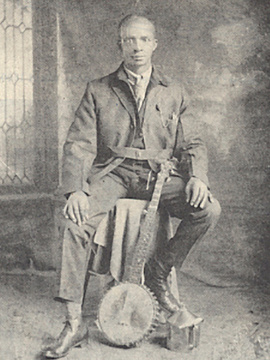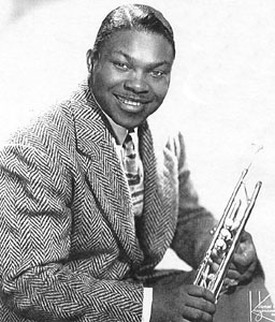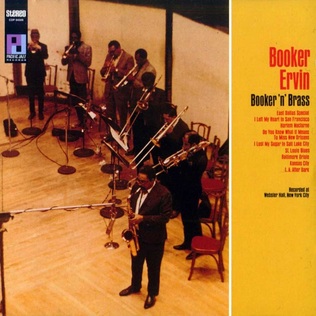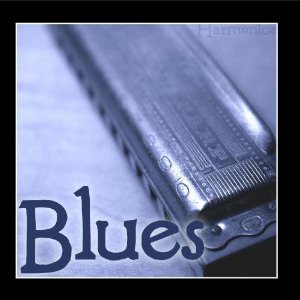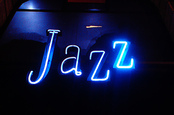BLUES ARTIST BIRTHDAY:
Gus Cannon (1883) - Gus Cannon was the best known of all the jug band musicians and a seminal figure on the Memphis blues scene. His recollections have also provided us with much of our knowledge of the earliest days of the blues in the Mississippi Delta. Cannon led his Jug Stompers on banjo and jug in a historic series of dates for the Victor label in 1928-1930. The ensemble usually included a second banjoist or guitarist, one of whom often doubled on kazoo, and the legendary Noah Lewis on harmonica. The jug-band style enjoyed a revival during the folk boom of the '50s and '60s, resulting in an ultra-rare Gus Cannon album on the Stax label after his "Walk Right In" became the nation's best-selling record for the Rooftop Singers in 1963. Only 500 copies of this 1963 album were pressed in its original issue, which explains why this legendary blues artist is known to only a handful of collectors. Although the phrase “jug band” and its country connotations may turn off the casual listener, Cannon’s voice, the banjo picking and the lyrics give no doubt of this man’s influence on future generations of blues and rock and roll musicians. He is reported to have died on October 15, 1979.
JAZZ ARTIST BIRTHDAY:
Cat Anderson (1916) - William Alonzo “Cat” Anderson was arguably the greatest high-note trumpeter of all time. His solo on "Satin Doll" from Duke Ellington's 70th Birthday Concert is a perfectly coherent chorus consisting of notes that are so high that it is doubtful if another trumpeter from all of jazz history could hit more than one or two. He first learned trumpet while at the Jenkins Orphanage in Charleston and toured with the Carolina Cotton Pickers, a group in which he made his recording debut. During 1935-1944, Anderson played with many groups including those of Claude Hopkins, Lucky Millinder, Erskine Hawkins, and Lionel Hampton. Hampton loved his high-note mastery, although Hawkins reportedly fired Anderson out of jealousy. In 1944, Cat Anderson was first hired by Ellington and it ended up being the perfect setting for him. Ellington enjoyed writing impossible parts for Cat to play, and Anderson received publicity and a steady income. He was more than just a high-note player, being a master with mutes and having a fine tone in lower registers, but no one could really challenge him in the stratosphere (although Maynard Ferguson, Jon Faddis, and Arturo Sandoval have come close). Anderson was with Ellington during 1944-1947, 1950-1959, and off and on during 1961-1971. Occasionally he would go out to lead his own bands but he always came back. After Ellington's death, Cat Anderson settled on the West Coast where he often played with local big bands, including an exciting one led by Bill Berry. Although his erratic behavior over the last decade (or more) of his life was well documented, it took many by surprise when he died in 1981 of a brain tumor.
JAZZ ALBUM RECORDED:
Booker Ervin – Booker ‘n’ Brass (1967)
Track Listing:
1. East Dallas Special
2. Salt Lake City
3. Do You Know What It Means to Miss
New Orleans?
4. L.A. After Dark
5. Kansas City
6. Baltimore Oriole
7. Harlem Nocturne
8. I Left My Heart in San Francisco
9. St. Louis Blues
10. L.A. After Dark
11. L.A. After Dark
Review by Michael G. Nastos at Allmusic:
To hear Booker Ervin as the leading solo voice on a recording with a larger ensemble is a treat, not only for his fans, but for those interested in modern big-band sounds grown from the bop era that are flavored with urban blues. A trio of different sessions done at Webster Hall in New York City features groups ranging from ten to eleven pieces, with personnel switched up, and no supplemental saxophonists. Freddie Hubbard is the only other soloist besides Ervin, the trombone section features top-rate players Bennie Green, Britt Woodman, and Garnett Brown, and the rhythm section of pianist Kenny Barron, bassist Reggie Johnson, and drummer Lenny McBrowne is as solid as can be. The session is based entirely on themes dedicated to major cities in the U.S.
Three versions of "L.A. After Dark," featuring different solos from Hubbard, are included on the CD version, written by the arranger of the date Teddy Edwards, a quintessential uptown homage to his adopted home. Ervin's "East Dallas Special" - a mix of "Night Train" and "Sister Sadie" - and the short, tuneful Jerry Lieber-Mike Stoller penned hit of Wilbert Harrison's "Kansas City," and the energetic 12-bar "St. Louis Blues" all shuffle along, powered by the soulful McBrowne. Four typical standards are included, with Ervin's tart-sweet post-John Coltrane saxophone sound undeniably leading the way. "Do You Know What It Means to Miss New Orleans?" is a slow spare horn chart accented by the booming bass of Johnson, while "I Left My Heart in San Francisco" is a polite and heartfelt treatment of this all-time favorite. "Harlem Nocturne" is quite dissimilar from the Joe Harnell hit version of the era, this one approximating tango proportions. Closest to true big-band regalia, "Salt Lake City" depicts a not very jazzy or bluesy city with a sophistication that suggests the best progressive charts of Duke Ellington, and especially Oliver Nelson, with two-note horn shout-outs. While the charts of Edwards and the emphasis on brass instruments holds interest, the overall sounds are only somewhat arresting. Ervin is the straw that stirs this tasteful martini, but he is heard to better effect on his numerous small ensemble recordings, and especially his work with Charles Mingus.
1. East Dallas Special
2. Salt Lake City
3. Do You Know What It Means to Miss
New Orleans?
4. L.A. After Dark
5. Kansas City
6. Baltimore Oriole
7. Harlem Nocturne
8. I Left My Heart in San Francisco
9. St. Louis Blues
10. L.A. After Dark
11. L.A. After Dark
Review by Michael G. Nastos at Allmusic:
To hear Booker Ervin as the leading solo voice on a recording with a larger ensemble is a treat, not only for his fans, but for those interested in modern big-band sounds grown from the bop era that are flavored with urban blues. A trio of different sessions done at Webster Hall in New York City features groups ranging from ten to eleven pieces, with personnel switched up, and no supplemental saxophonists. Freddie Hubbard is the only other soloist besides Ervin, the trombone section features top-rate players Bennie Green, Britt Woodman, and Garnett Brown, and the rhythm section of pianist Kenny Barron, bassist Reggie Johnson, and drummer Lenny McBrowne is as solid as can be. The session is based entirely on themes dedicated to major cities in the U.S.
Three versions of "L.A. After Dark," featuring different solos from Hubbard, are included on the CD version, written by the arranger of the date Teddy Edwards, a quintessential uptown homage to his adopted home. Ervin's "East Dallas Special" - a mix of "Night Train" and "Sister Sadie" - and the short, tuneful Jerry Lieber-Mike Stoller penned hit of Wilbert Harrison's "Kansas City," and the energetic 12-bar "St. Louis Blues" all shuffle along, powered by the soulful McBrowne. Four typical standards are included, with Ervin's tart-sweet post-John Coltrane saxophone sound undeniably leading the way. "Do You Know What It Means to Miss New Orleans?" is a slow spare horn chart accented by the booming bass of Johnson, while "I Left My Heart in San Francisco" is a polite and heartfelt treatment of this all-time favorite. "Harlem Nocturne" is quite dissimilar from the Joe Harnell hit version of the era, this one approximating tango proportions. Closest to true big-band regalia, "Salt Lake City" depicts a not very jazzy or bluesy city with a sophistication that suggests the best progressive charts of Duke Ellington, and especially Oliver Nelson, with two-note horn shout-outs. While the charts of Edwards and the emphasis on brass instruments holds interest, the overall sounds are only somewhat arresting. Ervin is the straw that stirs this tasteful martini, but he is heard to better effect on his numerous small ensemble recordings, and especially his work with Charles Mingus.
